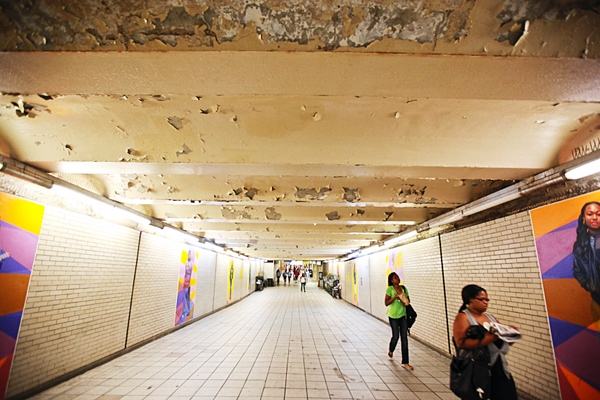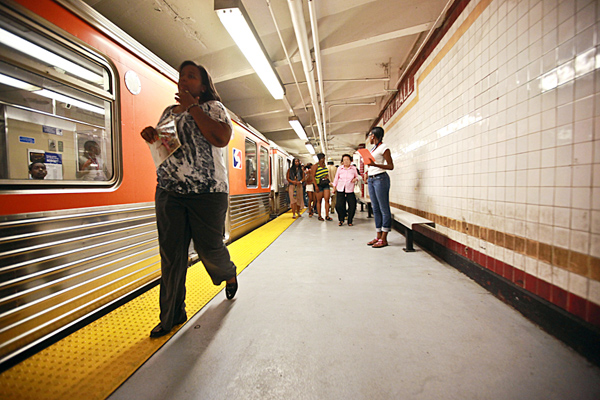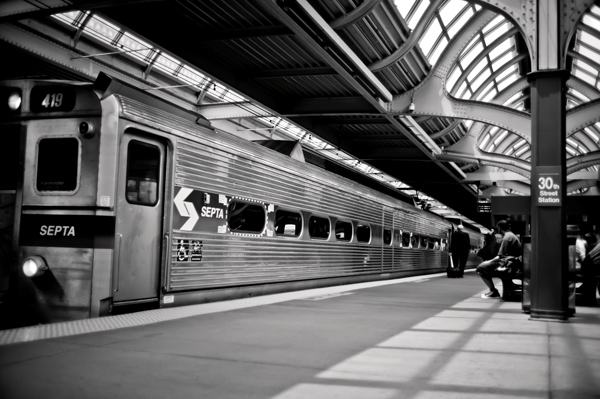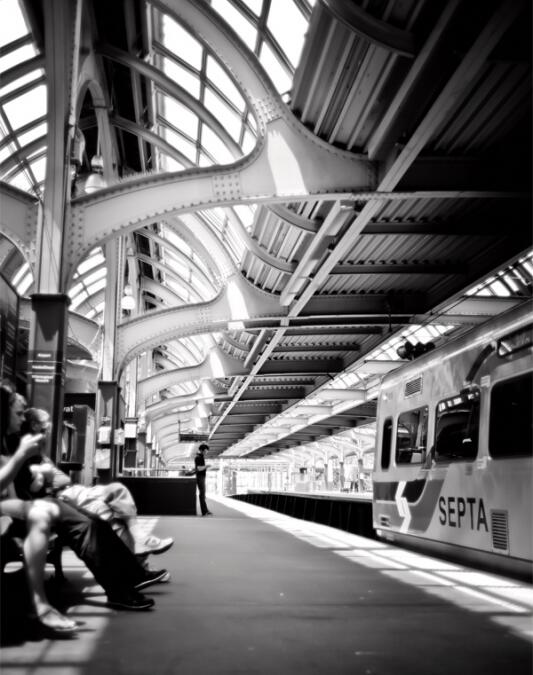Neal Santos
Self-hating Philadelphians love to complain about the city and its services. One of their favorite targets? The underrated, underfunded, enormous and, yes, aromatic Southeastern Pennsylvania Transportation Authority, known with strained affection as SEPTA.
Linger even a few minutes around City Hall Station and its not hard to find a dissatisfied customer. The subway is loud, smelly, full of rude people, gripes Jackie Ross, a self-employed 50-year-old from South Philadelphia who has been riding public transit in the city for more than three decades.
People smoke on platforms, leave half-eaten animal carcasses on seats and beat up drivers; in one infamous incident in 2011, two men indiscriminately strafed a bus full of people with gunfire over a verbal dispute that happened earlier on the route.
Yet on a typical day, the long-underfunded system performs a small miracle: getting thousands of people where they need to go. Last year, SEPTAs subways, trolleys, commuter rails and buses supplied nearly 334 million rides its highest ridership in 22 years.
However, the nations sixth-largest transit system is not contemplating expanding services to meet the growing demand. Instead, Republican hostility in Washington and Harrisburg is pushing SEPTA and other public-transit agencies nationwide to the brink of fiscal and physical ruin.
Service adjustments, service cuts, [hiking] fares, tightening the belt in-house well have to look at all those options, says SEPTA chief financial officer Richard Burnfield.
To avoid service cuts and ensure that ancient bridges dont collapse, SEPTA is currently spending down its rainy-day fund. Next year, the agency projects a $38 million deficit, and predicts that will rise to an astonishing $160 million by 2018. Infrastructure, from commuter-rail bridges to the decrepit City Hall Station, is falling apart. SEPTA cannot afford to put building a world-class transit system on the agenda.
That [deficit is] a big number, says Burnfield. SEPTA needs a fix.
In Washington, the right-wing takeover of the Republican Party has placed mass transit in a tight fiscal headlock. Earlier this year, House conservatives proposed eliminating the 20 percent of federal transportation dollars dedicated to mass transit. They now insist that a new transportation-funding bill include an unrelated amendment to fast-track approval of the environmentally dangerous Keystone Pipeline and, in a symbolically rich gesture, bar the use of those federal dollars for bike lanes. Conservatives have long derided mass transit like welfare, perceived to be the domain of poor urban black people as a socialistic program imported from Europe. But recently, the hostility has gone off the rails: Tea Party activists around the country have been packing city halls to decry everything from bike lanes to high-speed trains as part of a United Nations conspiracy to create a one-world order.
So here we are: The last six-year bill funding highways and mass transit expired three years ago, and Congress has extended funds in small three- to six-month increments ever since. Current funding runs out on June 30.
On the state level here in Pennsylvania, the situation is no better. In April 2011, Republican Gov. Tom Corbett convened a committee to study fixing the state transportation – funding system. Last August, the committee published its report. It proposed raising taxes paid by fuel distributors and increasing driver and vehicle fees to raise what the state has calculated to be $3.5 billion in urgently needed additional transportation spending, to climb to $7.2 billion in unfunded needs by 2020.
Yet Corbett, a governor who has acted decisively to eviscerate the states public schools and make deep cuts to social services for the poor, took no action. In his February budget address, he announced that he would, once again, punt on the issue of transportation funding.
Transportation, he said, is not a budget item. It is too large for that. Transportation must be confronted as its own distinct and separate topic. This problem has grown for the past several decades, and it will not be solved overnight.
Increasingly, it is unclear whether Corbett plans to solve it ever.
Corbetts ideology is: He wants less government spending, says state Sen. Mike Stack (D-Phila.), who has called for a special legislative session to pass a transportation funding measure. Thats an easy thing to say; its an extremely difficult task to perform. He now understands that his own commission says that hes behind on [transportation infrastructure] by billions of dollars. And its news that his ideology doesnt want to accept.
Corbett, however, is not concerned with SEPTAs plight.
It is incumbent upon SEPTA, PennDOT spokeswoman Erin Waters tells City Paper, to meet operational and safety requirements. It might then be incumbent upon SEPTA to self-destruct.
In Germantown, SEPTAs Wayne Junction Substation looks like a museum of early-20th-century industrial technology. Unfortunately, the equipment, mostly dating to the 1930s, is not merely a historical artifact; it supplies power to SEPTAs Doylestown, Warminster, West Trenton, Fox Chase, Chestnut Hill East and Norristown lines. SEPTA considers the station to be in urgent need of an overhaul, but has no funding to undertake it. An equipment failure could knock all six lines out of service and cause problems for several others. Just recently, Phillys congressional delegation trumpeted the news that it had secured $12.8 million in federal Department of Transportation funding to update the substation but even that windfall amounts to only half of what SEPTA says it needs.
The bridges are also crumbling. The Media-Elwyn Lines Crum Creek Viaduct, an architectural curiosity built in 1895, is now supported by corroding steel columns and cracked welding. Its also considered to be beyond its useful life.
In Center City, the entire subway network converges at City Hall Station. The subterranean complex connects two subway lines with SEPTAs trolleys, but is also a cramped rabbit warren of tight, crumbling and dank corridors, inaccessible to disabled people, that has undergone no major renovation since its 1928 construction. The main access to the Broad Street Line is a couple of narrow stairwells that during rush hour feel like cattle chutes.
SEPTAs annual capital budget, says SEPTA chief engineer Jeff Knueppel, now stands near a woefully inadequate $300 million. The lack of long-term federal and state funding makes planning for big, expensive projects impossible, so the agency prioritizes patching the systems wounds with what little funds they have.
Were scrappy, were cheap, were innovative and were holding the system together now. But at some point, if we go with this little capital funding, safety issues could slow train speeds and close commuter lines, he says. What do we really need to be replacing things and not necessarily even having much growth? Its around $600 million.
Transit systems statewide and around the country are in crisis. In 2010, nearly 80 percent of public transit systems hiked fares, cut service or considered doing so, according to the American Public Transportation Association. Meanwhile, questionable Wall Street debts continue to eat away at transit budgets. During the heady days of deregulated, pre-recession America, SEPTA like school districts, cities and transit agencies around the country took out interest-rate swaps on bonds to protect against high rates. But this backfired when the recession crashed interest rates, indebting taxpayers and transit riders to the same banks they had just bailed out.
SEPTA, according to a recent report from the ReFund Transit Coalition, is paying $4 million a year to Bank of America. The city of Philadelphia, which helps fund SEPTA, is paying $35 million to Bank of America, JPMorgan Chase, Citigroup and the Bank of Canada, having already paid $34 million to terminate a set of toxic swap deals with many of the aforementioned banks and Wells Fargo in 2010. Banks continue to profit from the Feds low interest rates and, more opaquely, also profit from the billions of dollars in interest-rate-swap payments. The study found that in the 12 regions surveyed including New York, Chicago, Boston, San Francisco and Los Angeles transit agencies lose more than $529 million each year to Wall Street.
Anxious riders need only look west to Pitts-burgh, where the Port Authority has paid tens of millions of dollars to cancel toxic swaps and is now set to eliminate nearly half of its 102 bus lines and hike fares. DialAmerica has delayed plans to open a new 150-person call center in the city, according to a recent article in the Wall Street Journal, because the company fears that employees wouldnt be able to get to work.
Nonetheless, nationwide ridership continues to make historic gains: Americans took 5 percent more rides in the first quarter of 2012 than they did a year earlier 125.7 million additional trips. Last week, the Amalgamated Transit Union (ATU) and Good Jobs First announced the creation of Americans for Transit to fight cuts and help rider organizations protest nationwide. Transit is a major social-justice issue of our day, says ATU International president Larry Hanley. Ridership is the highest in decades, but riders have suffered the worst wave of fare hikes and service cuts in postwar history.
 Neal Santos
Neal Santos
The City Hall Station and concourse system havent seen a major renovation since its construction in 1928.
Were Getting There, as locals know, is SEPTAs slogan, often mocked for its defeatist undertone. Just five years ago, though, it seemed possible that the transit agency could truly arrive.
Act 44 of 2007, a bill intended as a permanent fix for Pennsylvanias perennial transportation-funding problem, was set to generate about $900 million in annual infrastructure funding. But though the bill passed, it had a fatal flaw: About half of that planned revenue was slated to come from new tolls on I-80, a move the Federal Highway Administration rejected. Three times. The state borrowed money to boost funding to SEPTA and other transportation projects for the next three years, but had to start making deep cuts in 2010. SEPTAs annual capital budget took a $110 million hit.
When the agencys rainy-day fund runs dry in July 2013, SEPTA riders could find themselves revisiting the very moment Act 44 was supposed to ensure never, ever happened again.
The date was Nov. 11, 2004, and SEPTA, facing a $62 million deficit, announced what would come to be known as the doomsday scenario: Fares would rise by 25 percent, weekday service would be cut by 20 percent and mass layoffs would be implemented on Jan. 23 of the following year. On March 1, fares would spike again and more workers would be cut. Weekend service would be entirely eliminated.
Activists, however, were ready. The year before, a coalition with roots ranging from wealthy Chestnut Hill to North Phillys Nicetown had fought SEPTAs proposal to cut the R8 commuter line. But in 2004, SEPTA and the activists, who just the previous year had been on opposite sides of protests, joined together to fight Harrisburg.
The proposed systemwide cuts, unlike the proposal to scrap a single line, allowed them to mobilize forces across the metro region, says longtime mass-transit activist Marc Stier. He says SEPTA got the message he and others sent: You cant do this pick-and-choose, Were going to close this line; were going to close that line, because then we have to fight you. You have to threaten across-the-board cuts, because then were all fighting together.
It was a chaotic year in Harrisburg. Rural conservatives fought proposals to increase motor-vehicle fees and demanded highway funding for their districts. Meanwhile, Gov. Ed Rendell continued to transfer state and federal highway dollars to transit to stave off doomsday. Yet Republicans dithered. And so on Feb. 28, 2005, Rendell (a governor whose legislative genius sparked both admiration and condemnation) solved the problem on his own, using $412 million of a new batch of federal highways dollars to cover transit statewide for two years.
Republicans, of course, were infuriated. And it was a solution that guaranteed future problems. So two years later, Rendell struck upon a popular solution: Act 44. At the time, things seemed bright.
With ridership up, a new general manager, and a new predictable stream of state subsidies, the Inquirer reported in May 2008, SEPTA breezed through its budget season with unfamiliar calm.
After tolling I-80 fell through in 2010, Rendell, his second and final term drawing to a close, scrambled. The legislature, he said, needed to show political courage and pass increases in vehicle fees and the gas tax, and a gross-profits tax on oil companies. He called for a special legislative session and even proposed privatizing the turnpike to fund transportation, an idea that managed to prompt opposition across the political spectrum.
Republicans, looking ahead to the midterm elections, balked. Now, with the entire state government under his partys control, Corbett has done the same. Harrisburg, which used to work dirty, simply no longer works.

Neal Santos
The important Wayne Avenue Substation in Germantown is deemed beyond its useful life, and requires $25 million in repairs. SEPTA has access to just $12.8 million.
One of the things that makes SEPTA so much more interesting than Washington, D.C.s efficient but staid Metro, chock full of business-suited bureaucrats and lawyers, is the theater: commuters packing West Philadelphia street corners every weekday morning looking for the trolley like spectators at an imminent parade; shell games on the El that might cost you $40 or that pretty necklace; men selling incense, black soap, shea butter, incense, black soap, shea butter; an old white lady making smiley faces at a Latina womans extraordinarily cute baby.
But all of those scenes are a long way from where much of SEPTAs fate is determined, in the Harrisburg political theater that frequently spills out into the Capitol Rotunda, where protests and press conferences are organized for and against gun control, school vouchers and abortion rights.
It was there, on April 16 of this year, that Rep. Rick Geist (R-Blair) stood before reporters at a press conference calling for transportation funding. The longtime House Transportation Committee chairman was a critical supporter of infrastructure spending, and people on both sides of the aisle were looking to him to help solve the crisis. We have terrible transportation problems, said Geist, flanked by labor and business leaders. He warned that Pennsylvania could suffer a disaster like the one in Minneapolis in 2007, when a bridge known to be structurally deficient collapsed into the Mississippi River during rush hour, killing 13 and injuring 145.
The Pennsylvania Republican Party, however, had other priorities. One week later, Geist lost his primary race to a Tea Party-backed Penn State-Altoona finance professor, talk-radio host and political newcomer named John McGinnis.
I oppose Mr. Geists efforts in the past to raise gas taxes and generally oppose his desire to toll certain interstates in the commonwealth, McGinnis tells CP. I would concur with his efforts to sell the turnpike provided that the revenues generated were guaranteed to go to road transportation funding and not to Philly and Pittsburghs mass-transit systems or anything else. McGinnis represents the brave new Pennsylvania Republican Party that Corbett now leads. Initially regarded as a business-minded moderate, the governor signed Washington power broker Grover Norquists no new taxes pledge while fighting off right-wing primary challenger Sam Rohrer in 2010.
Since then, Corbett has balked at even the most straightforward and popular revenue measures, such as imposing a severance tax on booming natural-gas companies. When he finally approved such a fee this February, it was one of the lowest in the nation, and came with stipulations to the press that it wasnt really a tax, per se. Raising taxes of any kind, raising fees … hes really reluctant to do that, says G. Terry Madonna, a political scientist at Franklin and Marshall College.
Republican politics in Pennsylvania are no longer determined by the commonwealths challenges. Increasingly, state-level Republican priorities from Harrisburg to Tallahassee are dictated by national power players like Norquist and organizations like the American Legislative Exchange Council, a controversial group that brings conservative legislators and corporations together to write and lobby for model bills.
Who is Grover Norquist? asks Stack, the state senator from Philly. Who elected him?
Still, perhaps Harrisburg will come through and save SEPTA at the last minute, as they have in the past. Dick Voith, an economist at Econsult and a former Philadelphia representative on the SEPTA board, hopes so. But this time, he concedes, the Tea Party moment makes things uncertain. That businessmans end-of-the-day certainty that government serves some important, nonpartisan functions is vanishing.
You cant have Philadelphia without a good transit system, he says. End of story. You cant have suburban Philadelphia.
Pennsylvania politics have turned toward life, liberty and limited government. And conservatives have long expended considerable energy to apply that last principle to Philadelphia.

Neal Santos
The Broad Street Line connects with the El and trolleys, but visions of a more comprehensive transit complex have never been realized.
Just before 3 p.m. on a Tuesday in May, I walked into a SEPTA board meeting full of white men, a stark contrast to the diversely populated and majority-black trolley and El train I had taken there from West Philly. The suburbs dominate SEPTA, even though city riders make up 83 percent of fares and Philadelphia provides more than four times as much local funding as the four suburban counties combined.
In SEPTAs rendition of democracy, each county, Philadelphia included, gets two representatives on the SEPTA board; the governor also gets a seat, along with the House and Senate majority and minority leaders.
Even the organization that represents SEPTA riders, the Delaware Valley Association of Rail Passengers, has traditionally been run by commuter-rail users. Phillys riders have nothing like the Bus Riders Union, Los Angeles grassroots organization of transit users, to represent them.
SEPTA has been skewed toward the suburbs since its creation, when the federal government after decades of building highways like the two that were rammed through Center City passed the first major legislation to fund mass transit in 1964. SEPTA and City Hall immediately got behind a plan to spend their share of the money: a $300 million tunnel connecting suburban commuter lines at Suburban, 30th Street and the planned Market East stations. Urban transit riders, from East Poplar to the Richard Allen Homes to Chinatown to the Northeast, protested and argued discrimination. The commuter-rail tunnel, a federal lawsuit alleged, would result in suburban riders receiving $3,000 per rider in annual federal subsidies, compared to $187 per rider for city dwellers.
Regional leaders had prioritized suburban vehicle commuters for decades; now they decided to embrace suburban train commuters instead.
You had a perfect storm in the 1970s, and everything that could go wrong went wrong, says Jake Kobrick, a historian who wrote his dissertation on the history of Philadelphia transportation. Inflation drove maintenance and labor costs up nationwide, and cities teetered on the edge of bankruptcy. The most astonishing part of the entire story is that, in the midst of this perfect storm in the 1970s, SEPTA and Philadelphia pushed ahead with the commuter connection.
Meanwhile, construction delays and skeptical federal officials wreaked havoc on Phillys federal transit funds. By late 1969, the Philadelphia region had received just $4.8 million in Urban Mass Transportation Act funding, while the New York City, Chicago, Boston and San Francisco regions received $100 million apiece. SEPTAs tunnel was finally completed in 1984.
Today, funding is still biased toward the well-to-do. A federal grant funds the Center City Districts ambitious $50 million remaking of City Halls Dilworth Plaza into a higher-end destination, while SEPTA lacks the funds to complete $100 million in renovations to the station underneath. Indeed, City Paper discovered in April that the privately run Center City District had beaten out SEPTAs own application for stimulus funds, money the agency intended to spend on a new smart-card fare system.
SEPTA ultimately secured $175 million from the Philadelphia Industrial Development Corp. to pay for the fare-system upgrade. But the funding from the Immigrant Investor Programs Welcome Fund, a controversial federal program through which foreign investors get permanent residency in exchange for investments highlights the bizarre measures to which cash-strapped SEPTA must resort.
 Neal Santos
Neal Santos
The urban-suburban divide, however, is an oversimplification. Ultimately, suburbanites and city dwellers will need to pass something like a five-county transit tax to help fund the system fully. And Philadelphians use suburban lines too particularly the working poor who depend on trains, buses and trolleys to commute to the many jobs that have relocated to megastores, malls and office parks over past decades. The much larger issue is that the entire five-county system needs more cash. And it always has, because SEPTA never recovered from the for-profit mess it took over upon the agencys 1964 creation.
The federal government invested enormous sums in highways and mortgage assistance for whites-only suburban homes after World War II. The urban population scattered and mass-transit ridership along with Philadelphias clout in Harrisburg plummeted. The car symbolized the height of American individuality, while subways evoked Soviet collectivism. By the 1950s, the privately owned subways, buses, trolleys and commuter lines had descended into crisis. Between 1968 and 1983, SEPTA took over the various companies that ran those lines to save mass transit from collapse.
The Philadelphia Transportation Company, which ran the city train, bus and trolley lines, had a terrible public-relations image, says Kobrick. On day one, SEPTA became responsible for that. And I dont think theyve ever recovered.
By 1974, the city Department of Public Property reported that Philadelphians considered transit to be dirty, dark and unsafe. WCAU television news described subway and El cars as strewn with filth, drunks, graffiti and junkies. The dark, dank stations reek of who knows what, and shelter muggers and rapists. Later that decade, fires on the Broad Street Line caused dozens of injuries.
The newborn transit agency was both ahead of its time and way, way behind. Ahead, because it was a regional operation from the start cities like Boston and New York took over private urban mass transit in the 1940s and 50s and only decades later created regionally governed authorities. But behind, because SEPTA was one of the last systems to remain under private ownership, left to deteriorate as other cities reinvested in mass transit.
Initially, SEPTA hoped to catch up quickly. After visiting transit systems in London and Paris in 1971, SEPTA chairman James McConnon proposed a total transit complex for Philadelphia, with more subway and rapid-transit lines for greater flexibility.
The nickel-and-diming of transit has long since foreclosed on the possibility of dreaming big.
But some of those dreams are mouthwatering: There are proposals, for example, to add a Market-Frankford line station between 15th and 30th streets, to extend the Broad Street line south to the Navy Yard and to increase the number of Regional Rail stops inside city limits.
Light rail or high-speed bus lines, SEPTA says, could be installed along Roosevelt Boulevard. The Norristown High Speed Line, which departs from 69th Street Station, could be extended to King of Prussia. A light-rail line is envisioned running from City Hall to the Delaware River waterfront, then along the river from Pier 70 in South Philly to Girard Avenue. And high-speed buses or light rail could run through the abandoned Reading Viaduct, connecting Center City to the Art Museum, Fairmount Park and the Philadelphia Zoo perhaps going all the way to the Mann Center.
All this could complement a high-speed Amtrak line from D.C. to Boston, with speeds up to 220 miles per hour bringing an estimated 10.5 million people within an hour of Philadelphia.
This could mean, in short, jobs created, economy stimulated and peoples lives made remarkably easier. The austerity regime, however, dissents, crying socialism and railing against another handout to those people in cities. Without the political will from local, state and national elected officials, SEPTA wont ever get back on track.
(ten.repapytic@rivned.leinad) (@DanielDenvir)

